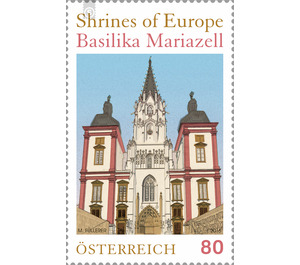churches - Austria / II. Republic of Austria 2016 - 80 Euro Cent
Theme: Architecture
| Country | Austria / II. Republic of Austria |
| Issue Date | 2016 |
| Face Value | 80.00 |
| Edition Issued | 265,000 |
| Printing Type | offset |
| Stamp Type | Commemorative |
| Item Type | Stamp |
| Chronological Issue Number | 2604 |
| Chronological Chapter | OOS-OE2 |
| SID | 490445 |
| In 68 Wishlists | |
Mariazell has a long history and many legends. The founding date is December 21, 1157 - a monk named Magnus should take care of the inhabitants of the area as a pastor. With him he led a self-carved statue of the Virgin from linden wood. According to legend, a rock blocked the way for him, so he turned to the Mother of God - promptly split the rock and cleared the way. At his destination, Magnus placed his statue of Mary on a tree trunk and built a wooden chapel all around. Over time, Mariazell grew up around this "Cella Mariae". According to the "legend of Henry", the first church was built around 1200 thanks to Margrave Heinrich of Moravia. He suffered from gout and in a dream was asked by St. Wenceslas to go to Mariazell for his healing and to build a church there. The church received a valuable image of Mary when King Ludwig I of Hungary turned against the Turks to the "Mother of God from Mary to Zell" and won a victory. From "Maria in the cell" was the name of the place, which was first documented in 1243. In 1344, Mariazell became a market and was already known as a place of pilgrimage in the 14th century. Around 1370, a Gothic church was built. In the course of the Counter-Reformation, the Habsburg rulers Mariazell made the national shrine. Soon, the Gothic church was too small for the pilgrimage, in the 17th century was therefore a baroque extension. It is precisely this style mixture that makes up to this day the special character of the church, which was raised in 1907 to the basilica minor. It is decorated in the colors terracotta and white and has a gothic center tower and two baroque towers. The Baroque high altar consecrated in 1704 was created by Johann Bernhard Fischer von Erlach. In the Chapel of Grace is the statue of Mary from the founding legend, the 48 centimeter tall late Romanesque statue of Our Lady - the Magna Mater Austriae.


